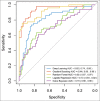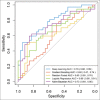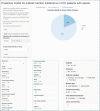Development and validation of a predictive model for feeding intolerance in intensive care unit patients with sepsis
- PMID: 34528519
- PMCID: PMC8919923
- DOI: 10.4103/sjg.sjg_286_21
Development and validation of a predictive model for feeding intolerance in intensive care unit patients with sepsis
Abstract
Background: Feeding intolerance in patients with sepsis is associated with a lower enteral nutrition (EN) intake and worse clinical outcomes. The aim of this study was to develop and validate a predictive model for enteral feeding intolerance in the intensive care unit patients with sepsis.
Methods: In this dual-center, retrospective, case-control study, a total of 195 intensive care unit patients with sepsis were enrolled from June 2018 to June 2020. Data of 124 patients for 27 clinical indicators from one hospital were used to train the model, and data from 71 patients from another hospital were used to assess the external predictive performance. The predictive models included logistic regression, naive Bayesian, random forest, gradient boosting tree, and deep learning (multilayer artificial neural network) models.
Results: Eighty-six (44.1%) patients were diagnosed with enteral feeding intolerance. The deep learning model achieved the best performance, with areas under the receiver operating characteristic curve of 0.82 (95% confidence interval = 0.74-0.90) and 0.79 (95% confidence interval = 0.68-0.89) in the training and external sets, respectively. The deep learning model showed good calibration; based on the decision curve analysis, the model's clinical benefit was considered useful. Lower respiratory tract infection was the most important contributing factor, followed by peptide EN and shock.
Conclusions: The new prediction model based on deep learning can effectively predict enteral feeding intolerance in intensive care unit patients with sepsis. Simple clinical information such as infection site, nutrient type, and septic shock can be useful in stratifying a septic patient's risk of EN intolerance.
Keywords: Deep learning; enteral feeding intolerance; predictive model; sepsis.
Conflict of interest statement
None
Figures






Comment in
-
Predicting enteral feeding intolerance in patients with sepsis: Why and how?Saudi J Gastroenterol. 2022 Jan-Feb;28(1):1-2. doi: 10.4103/sjg.sjg_38_22. Saudi J Gastroenterol. 2022. PMID: 35083976 Free PMC article. No abstract available.
Similar articles
-
Development and Validation of a Prediction Model for Enteral Feeding Intolerance in Critical Ill Patients: A Retrospective Cohort Study.J Clin Nurs. 2025 Jun;34(6):2336-2347. doi: 10.1111/jocn.17660. Epub 2025 Jan 30. J Clin Nurs. 2025. PMID: 39888094
-
Enteral nutrition intolerance in critically ill septic burn patients.J Burn Care Res. 2014 Jul-Aug;35(4):313-8. doi: 10.1097/BCR.0b013e3182a22403. J Burn Care Res. 2014. PMID: 24879397
-
Nomogram to predict feeding intolerance in critically ill children.Eur J Pediatr. 2023 Dec;182(12):5293-5302. doi: 10.1007/s00431-023-05205-8. Epub 2023 Sep 19. Eur J Pediatr. 2023. PMID: 37723295
-
A review of feeding intolerance in critically ill children.Eur J Pediatr. 2018 Nov;177(11):1675-1683. doi: 10.1007/s00431-018-3229-4. Epub 2018 Aug 17. Eur J Pediatr. 2018. PMID: 30116972 Review.
-
Investigating key factors of feeding intolerance in sepsis: A scoping review.Nurs Crit Care. 2025 May;30(3):e70038. doi: 10.1111/nicc.70038. Nurs Crit Care. 2025. PMID: 40289386
Cited by
-
Risk prediction models for feeding intolerance in patients with enteral nutrition: a systematic review and meta-analysis.Front Nutr. 2025 Jan 14;11:1522911. doi: 10.3389/fnut.2024.1522911. eCollection 2024. Front Nutr. 2025. PMID: 39877537 Free PMC article.
-
Clinical practice guidelines for nutritional assessment and monitoring of adult ICU patients in China.J Intensive Med. 2024 Feb 2;4(2):137-159. doi: 10.1016/j.jointm.2023.12.002. eCollection 2024 Apr. J Intensive Med. 2024. PMID: 38681796 Free PMC article.
-
Using Machine-Learning to Assess the Prognostic Value of Early Enteral Feeding Intolerance in Critically Ill Patients: A Retrospective Study.Nutrients. 2023 Jun 10;15(12):2705. doi: 10.3390/nu15122705. Nutrients. 2023. PMID: 37375609 Free PMC article.
-
Different definitions of feeding intolerance and their associations with outcomes of critically ill adults receiving enteral nutrition: a systematic review and meta-analysis.J Intensive Care. 2023 Jul 5;11(1):29. doi: 10.1186/s40560-023-00674-3. J Intensive Care. 2023. PMID: 37408020 Free PMC article. Review.
-
Enhancing sepsis therapy: the evolving role of enteral nutrition.Front Nutr. 2024 Oct 1;11:1421632. doi: 10.3389/fnut.2024.1421632. eCollection 2024. Front Nutr. 2024. PMID: 39410931 Free PMC article. Review.
References
-
- Heyland DK, Ortiz A, Stoppe C, Patel JJ, Yeh DD, Dukes G, et al. Incidence, risk factors, and clinical consequence of enteral feeding intolerance in the mechanically ventilated critically ill: An analysis of a multicenter, multiyear database. Crit Care Med. 2021;49:49–59. - PubMed
MeSH terms
LinkOut - more resources
Full Text Sources
Medical
Research Materials

